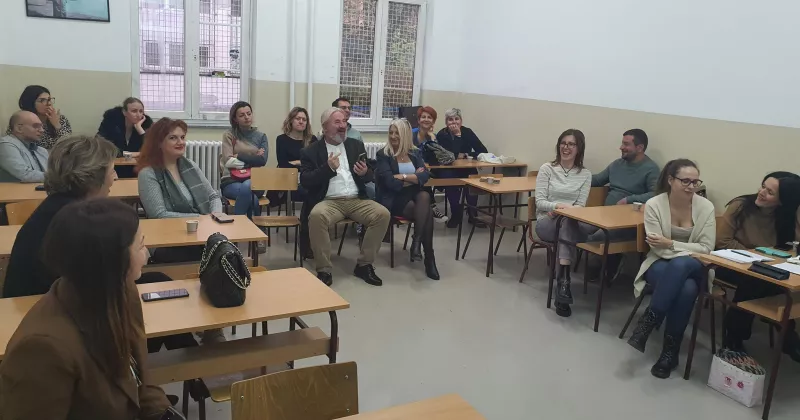Thematic week: Art helps you make sense of the world around you

 Dance Info Finland promotes the status of dance and helps develop the culture of dance in the national and international context. Photo: Arina Nagimova
Dance Info Finland promotes the status of dance and helps develop the culture of dance in the national and international context. Photo: Arina Nagimova
Dance Info Finland’s Erasmus + project strives to build up the digital competence of performing arts professionals. Rather than adapting art forms based on presence to the digital or virtual format as such, the objective of the project is to provide inspiration and increase understanding of the new opportunities and performance types enabled by digitalisation.
"You need art to make sense of the world and your own place in it", says Katarina Lindholm, Manager of International Affairs at Dance Info Finland.
Dance Info Finland has launched its first Erasmus + project titled Digital Leap: Capacity building for circus and dance professionals. The objective of the project is to develop circus and dance professionals’ digital competence. While the activities are only taking their first steps, the starting points are inspiring and promising.
“Dance and circus are international, also as forms of art", explains Lindholm.
Dance Info Finland is a small expert organisation and one of eight art information centres in Finland. It strives to promote the Finnish art of dance by facilitating the export of dance art, organising events, finding new work opportunities for Finnish dancers, collecting statistics on dance in Finland and communicating about it in Finland and further afield.
Capacity building project
The Digital Leap project strives to develop dance and circus professionals’ skills, approaches and capabilities related to using digital and virtual tools in their work The project has eight partners from seven different countries: Finland, France, Norway, Spain, the Czech Republic, Sweden and Lithuania.
“The partners are our peer organisations whose task is to promote dance, internationalisation or other similar objectives in their various home countries. We have similar learning goals”, Lindholm says with enthusiasm.
The project consists of four training periods on digital content marketing, streaming of live performances, content sharing and work with audiences. Lindholm explains that this capacity building project also creates opportunities for international networking and peer learning.
“It is important to learn about these things together: between artists and together with experts and facilitators”, Lindholm stresses.
The training periods will be organised in connection with relevant art festivals in the partner countries, thus creating direct contacts with target audiences and an opportunity for the participants to show what they have learned. The idea is to plan and produce learning materials based on the training periods and, according to Lindholm, to disseminate them both nationally and internationally.
“We would like to see a general improvement in competence levels. It is in our common interest to help performing arts gain a foothold in the larger forum of digital content.”
 Project participants will familiarise themselves with the planning and implementation of content intended for digital dissemination. Photo: Arina Nagimova
Project participants will familiarise themselves with the planning and implementation of content intended for digital dissemination. Photo: Arina Nagimova
Digitalisation is a challenge and an opportunity
While the project focuses on the use of tools and instructions, an effort will also be made to increase participants’ understanding of the opportunities offered by digitalisation for live art. Lindholm regards digitalisation both as an opportunity and a challenge: dance and circus as performing arts are based on presence and encounters between performers and audiences. The project thus comprises a kind of balancing exercise.
“After all, not everything can be posted online or converted into a digital format", says Lindholm.
Lindholm believes that the project will be useful in many ways. Digitalisation can help reach a wider audience and provide additional means for achieving success and better competitiveness in the art market. The project has attracted a great deal of interest in Finland, and its theme stems from a genuine need that emerged during the pandemic. It also offers a great learning experience for the participating organisations.
“The project paves the way for more ecological practices”, adds Lindholm.
Even though the partner organisations compete with each other from the perspective of marketing communications, Lindholm believes that everyone has a common goal: developing the digital capacity of artists, authors or producers. Rather than competing against each other or protecting their contacts and capitals, the participants wish to develop together and share experiences and lessons learned.
“This is strongly associated with an operating culture of sharing, which I hope the project will encourage further. It will help us achieve a more sustainable operating environment in general.”
Lindholm expects that any challenges faced by the project may yet be ahead. While there is some uncertainty about the restrictions created by the pandemic, Lindholm believes that all problems can be solved.
New horizons
Lindholm considers dance and culture extremely important.
“The era of the pandemic has strongly highlighted people's need to experience art.”
Lindholm has enjoyed performances despite the pandemic, albeit occasionally from home as live streaming and recordings. Even if the central element of presence is lacking, she encourages people to also enjoy art remotely, as artists today know how to produce content of outstanding quality.
“A good performance will not fail to get its emotion and intensity across. You only need to focus.”
Lindholm believes that performing arts are today glimpsing new horizons, especially in the international context. Digitalisation can develop an art form and be a source of inspiration, for example for implementing new forms of hybrid performances.
“In order for us all to become slightly better aware of what opportunities there are and how they can be used, familiarisation and inquiry-based learning will be needed.”





